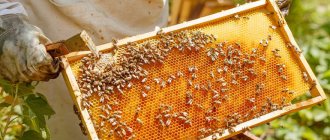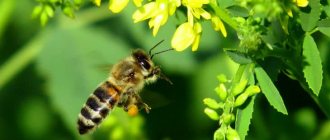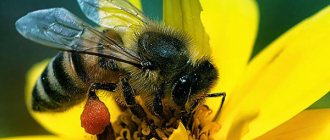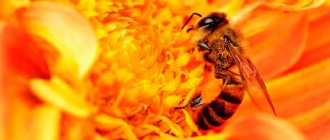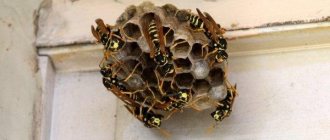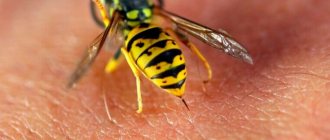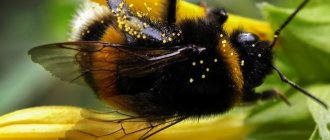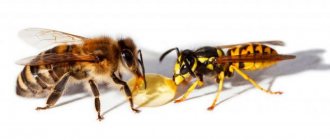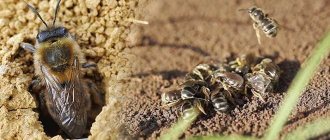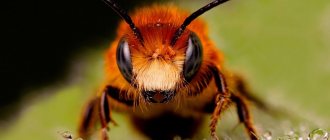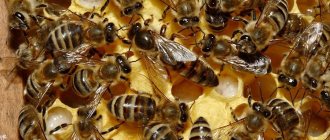To understand who a drone is and why it appears in a bee colony, it is worth considering the concept of parthenogenesis. Parthenogenesis is one of the forms of reproduction in which females are produced from fertilized cells, and males are produced from unfertilized cells, in our case, drones. During laying, the queen herself decides how many males and how many females there should be in the hive. Unfertilized eggs can also be laid by other females. Such bees are called tinder bees. Unlike the queen bee, which can lay two types of eggs, the tinder bee lays only unfertilized eggs, which produce male bees.
Drone bees
Let's take a closer look at what their functions are in bee society. Drones are males in a bee swarm whose task is to fertilize females. Otherwise, the drone is not obliged to do anything, except to warm the brood in the cold. The duration and quality of life are determined by bees; they decide when a drone is supposed to be born and when to end its life. While the “man” is useful to them, they feed him, warm him and cherish him, but when the honey collection ends, the bees throw him away, and he soon dies.
Drones hatch from unfertilized eggs laid in special cells (at about 24 days). This phenomenon - reproduction without the participation of a male cell - is scientifically called parthenogenesis. It allows any female to leave offspring without the participation of a male. It also regulates the numerical sex ratio: females are born from fertilized eggs, males or drones (in bees) are born from unfertilized eggs.
Cells with drone larvae are located around the perimeter of the honeycomb. If there is not enough space there, worker bees build them on honeycombs of bee cells. In total, about 400 drones are raised in one family, but the number of these insects sometimes exceeds a thousand.
Inexperienced beekeepers, seeing a drone on a frame, may think that it is a queen. But the drone is not like the queen. The drone's body is shorter. And he looks like a clumsy, round-headed fat man. A person need not be afraid of it, since it does not have a sting. Moreover, the drone's organs are not adapted for any work.
Development
The young drone emerges from the cell.
Convex lids of cells with drone brood are visible. The queen begins to lay drone eggs after the worker bees hatch (in central Russia in the first half of May); these eggs are laid in special larger cells (8 mm in diameter) - this is the so-called drone eggs.
After 3 days, larvae (drone worms) emerge from the eggs, which the worker bees feed with milk, honey and pollen.
The larvae develop for 6 days, after which the worker bees close the cells with convex (humpbacked) lids; The larvae turn into pupae, from which drones hatch after 15 days. Thus, the entire development of the drone lasts 24 days.
Drones are hatched in those swarms in which the queen is more or less old; the same bees that have a young queen, born in the same year (the same year), usually do not breed drones.
Sometimes drone eggs are laid by mistake in smaller cells intended for the development of worker bees. In such cases, these cells are also sealed with convex covers (humpbacked worm), and not flat, as when worker bees develop in them; the drones emerging from such cells are significantly smaller in size.
Life cycle of a drone
Features of the view
Drone bees are hardy and strong; thanks to the peculiarities of their eyes, they cover a large space, which significantly affects their ability to navigate. Developed sensory organs allow you to smell the female at a distance of 50 meters. Males differ from other bees in their high flight speed and short life span, which lasts from May to August.
When figuring out who a drone is in a bee family, it is worth noting that it leaves the hive mainly in the afternoon, less often in the evening, flies with a characteristic bass sound, and when it arrives, it descends heavily, as if falling. Over a short period of life, drones consume several times more food than working individuals.
Content
- Basic instinct or where drones come from
- Description of drones and their “privileges”
- How useful and necessary are drones in honey production?
- Drones as swarming prevention and resistance to Varroa mites
- From the experience of owners of personal amateur apiaries
- Method of selection of productive queens
- Medicinal properties of drones
A hard-working, industrious person is often called a worker bee, but a quitter, a parasite and a “freeloader” are given the honorary title of a drone. Today we will talk about the functional responsibilities, benefits (as paradoxical as it sounds), the “social” role of the drone, not in a metaphorical, figurative sense, but in a literal sense, as a beneficial insect. So, for what purpose does a bee colony raise and maintain a male drone, is it necessary to disrupt the natural course of life of bees, and how do beekeepers feel about this, read on.
The role of the drone in the bee colony
Each individual has strictly designated functions. The queens lay eggs, and the worker bees do all the housework. Drones are producers. They constantly rest and gain weight (a drone eats 5-6 times more food than a bee) to ensure the birth of offspring.
Each hive produces several thousand males during the season . Only 6-8 individuals mate with the queen. Why do bees feed such a huge number of “parasites”, spending a significant part of their food reserves on them? This is necessary to ensure that there are a sufficient number of male insects in the area. In this case, the queen will definitely meet the male. If there are few drones, then the queen may not meet them and remain unfertilized.
Previously, it was believed that the male part of the bee colony was necessary only for reproduction. Therefore, in order to save honey, it was recommended to destroy drone brood. But recently the opinion of scientists and beekeepers has changed. It has been observed that in the absence of drones, bees collect honey worse. Therefore, it is advisable to leave part of the brood.
In addition, the “male population” helps the bees increase the temperature in the nest, which allows the worker bees caring for the larvae to free themselves from their previous duties and engage in honey collection.
Method of selection of productive queens
The work is painstaking and requires compliance with the conditions, regime and sequence of actions:
- at the end of April, construction frames-baits for ticks are placed in all families;
- from mid-May, productive queens are bred separately, in selected colonies in the presence of worker bees;
- in May, the trap frames are gradually filled with drone brood;
- 1-2 more frames are added to each colony to limit the bees from laying honeycombs for drones;
- mid-May - dividing grids are placed on the detachable bottoms to prevent the swarm from flying out;
- separation grids control the “launching” of drones;
- The queens' broods are released into the wild along with the drones to copulate.
The method is effective - the “stock” of first generation queens is improved. In this case, the formation of families with an unknown gene pool is excluded by itself. In the last days of June, the drones are released again. By this time, it is better to remove the separation bars to avoid swarming. We must not forget about the reproduction of ticks. During this period, drone brood can be cut out from trap frames. The last treatment against Varroa mites is carried out in the fall, using special chemicals.
Fertilization
The drone is a full-fledged successor of the bee genus, since, ultimately, not a single individual can be born without its seed. There are not so many of them in each bee colony - several hundred. The male becomes sexually mature approximately on the tenth day of its existence.
Before fulfilling their duty, drones live in one swarm of bees. But when they fly out of their hive, they can count on the help of bees from other families. They are not chased away and are always fed, because they know who the drone is and that it can become a partner for their queen. How long a drone will live depends on many factors: whether there is a queen in the swarm, how capable she is of fertilization, and what is the general condition of the family. Much depends on weather conditions. But on average they live about two months.
The drone finds the female by catching the mother substance in the air. At the same time, he can distinguish it only at a considerable distance and at a height of more than 3 m above the ground, and the closer he flies to the female, the more he relies on vision. The inability to detect the pheromone at close range explains why mating does not occur in the hive. There he has to fight for the right to leave his seed for her, thus weeding out the weak individuals and leaving only those drone bees that carry the strongest genetic material in their somatic cells . About 6-8 males are required to fertilize a female. All of them, having fulfilled their purpose, die after a short period of time.
From the experience of owners of personal amateur apiaries
Since the late 80s. last century, it was proven that the hatching of drones is useful for increasing the performance and activity of bees. The second benefit is that the drone community is a surefire decoy for Varroa mite infestations. The productivity of the hive directly depends on the competent selection of the queen bee and drones. It is important to monitor the genetic makeup of the entire family.
Practical recommendations:
- A quick and effective way to support an apiary is to purchase and plant queens (artificially inseminated). There are disadvantages to this method - the queen bee needs to be replaced annually. Beekeepers note that an artificially inseminated queen does not take root well in the family; it is not accepted and is often replaced.
- A profitable way is to purchase reproductive queens with a targeted set of genetic characteristics. The uterus is genetically adapted to the local climate, region, conditions, vegetation. This is a kind of investment and accumulation of their own breeding material with the further breeding of their own queens. This selection method can increase productivity by at least 2 times.
What does he look like
Drones can be seen from the last month of spring to the last month of summer. These insects fly away in the afternoon and arrive home only in the late evening. A distinctive feature of the drone from ordinary bees is its rather large size compared to the queen bee and the bees themselves. It weighs 250 milligrams and is 15 centimeters long.
The drone has perfectly developed wings. It is interesting that the drone does not have: a sting; wax glands; proboscis, which acts as a food collector and carries it somewhere. Therefore, without outside care, he will not survive, he will not even be able to eat himself. Nature has endowed drones with everything they need for mating: excellent charm, excellent vision and high flight. The drone sees the female in flight and catches up with her faster than its rivals in order to mate.
Question answer
Why does the drone die after insemination?
Answer: To mate, the drone releases its organ, which is responsible for the birth of bees, which until that moment was inside it. It’s almost the same as a person’s internal organs coming out. Therefore, the drone dies without a chance to survive.
Is it possible to determine the breed of bees by the appearance of the drone?
Answer: Yes, you can! For example, drones in Caucasian bees are black, while outbred drones are gray. The “Italian” breed is red in color, and the forest drones are dark red.
What else does a drone do?
Sometimes there are cases when it remains for the winter, but still dies in the spring. In the bee family, he is not too overworked. He does not obtain food for himself (or other bees). But it plays the role of not only a seed distributor. Another function is protection from the cold. When frost sets in, these insects protect the brood with a living blanket, positioning themselves at the entrance to the hive. This is how they protect the laid eggs from being destroyed by the cold. Such self-sacrifice is justified by nature: all the drones will soon have to die anyway. As a rule, in the fall the bees expel the remaining drones from the hive, and they die of hunger and cold.
Lifespan
Drones live no more than two months. As summer comes to an end, the number of flowering plants decreases and nectar collection drops sharply. Therefore, the bees begin to get rid of “extra mouths.” They do not give the drones food and gradually push them towards the entrance, and then completely expel them from the hive.
As a result, insects die of starvation because they cannot obtain food. Drones remain in the hive for the winter only if the queen is old or absent, which indicates a dysfunctional family.
Significance in the bee family
First of all, the reader will have a question: why are drones needed in a bee colony if they cannot feed themselves, are gluttonous and do not help the working bees in any way? But they are the only individuals thanks to which the bee line continues, they are a flying sperm bank. To fulfill its duty, the drone must be resilient and strong, because it will have to travel long distances to find the queen. Also, they will have to compete with other drones hunting the same thing as himself.
The drones that the queen gives birth to carry the same genetic material as hers. Each male bee has chromosomes, of which there are 16 in total, and the queen has 32. As soon as two weeks have passed after hatching, the drone is ready to fertilize the queen.
And another purpose of a large number of bee drones is to preserve the life of the queen during the mating flights, since in a large mass of flying insects there is a high probability that the queen will not die from the enemies of the bees. And finally, the sooner the queen is fertilized, the sooner she will begin laying eggs and the faster the family will gain strength. And this, of course, is beneficial to the beekeeper.
Life cycle
The formation of one adult male from an unfertilized egg requires 24 days. As a rule, the cells for males are located along the edge of the drone foundation. The average number of drones from one family reaches 400 insects, although this figure is very arbitrary.
There are known cases when their number exceeded 1000 units. Throughout the entire period of development, worker bees tirelessly feed the larvae, whose diet consists of honey, milk and plant pollen.
With the onset of the first days of May, insects emerge from the drone foundation and undergo a process of adaptation to the changed environment. Feeding of the young does not stop for about 10 more days. A week after birth, the males make test flights outside the hive, and after 2 weeks they leave their sweet home to fulfill their biological purpose.
Acute sensory receptors help the male to easily identify the queen ready for mating, which signals the position with a “train” of pheromones. To become the top inseminator, the drone and its competitors fight a tough battle.
The result of mating for a man is his inevitable death. But this is far from the only threat that awaits the drones on the way to their goal. Birds of prey are always happy to feast on tasty and juicy insects. This means the death of the drones even before copulation begins.
The fertilized queen returns to the bee kingdom, and the males, who have become useless, are expelled from the community and then die of starvation. That's what the drone is for in a bee hive.
Interesting Facts
- Males have very well developed wings, they can fly high and long distances in search of the uterus. Drones are very voracious; one kg of these bees consumes more than twenty kilos of honey. This is for 2 or 3 months, they don’t live longer.
- Males eat 4 times more honey than females who extract this honey.
- In order for 1 kilogram of drones to survive, they eat more than half a kilogram of honey per day, which is almost 16 kilograms per month.
- Over the summer period, 1 kilogram of insects will consume 50 kilograms of honey.
- There are approximately 4000 drones in 1 kilogram.
- The flight of drones is accompanied by a loud buzzing sound. When he sits down on a certain resting board, he makes sounds as if he fell from fatigue.
Fatherlessness
Did you know that the drone is the only member of the bee family that is born without a father? Surprisingly, nature intended it this way. Honey bees, queen bees, and worker bees cannot be born if a representative of the opposite sex does not participate in the conception process. But drones can. They are born from unfertilized eggs. The queen lays them in special “drone” cells, which are much larger in size than ordinary ones. This is how fatherless bees are born in them.
Parthenogenesis is a common phenomenon in nature. Science knows many different species that produce offspring without the use of male seed. But what’s important is that it doesn’t have any negative effect. Drones are born strong, energy-intensive, strong and in all respects full-fledged bee “dads”.
Freeloaders or hard workers?
There are several opinions regarding the importance of drones in the bee colony. Some consider them exclusively parasites and lazy people, while others say that they are important members of the family, without whom one simply cannot do. Let's try to make a little comparative description and understand what the drone has more: pros or cons.
- The drone is the “father” of all bees. Unfortunately, that's all.
- Unable to guard the hive.
- Doesn't know how to feed larvae.
- Does not take any part in collecting pollen, does not know how to “make” honey and wax.
- He eats a lot.
The result, as you can see, is that the drone has more disadvantages. However, in defense of drones, the following can be said:
- If the drone had not fertilized the queen, then we would not have met a single bee in this world. It’s even a pity for the “bee fathers”, because they often fold their heads after fulfilling their “sacred” duty.
- They are not to blame for anything. It was nature that did not endow them with tools that would help protect and feed their family. They might be happy to join in with household chores, but they simply cannot do so due to the lack of important “tools.”
- These are just temporary members of the family. What happens if you combine their excellent appetite and permanent residence in the hive all year round? Yes, they will leave the family without supplies in a month. And by their “absence” from the hive in winter, they significantly save food.
